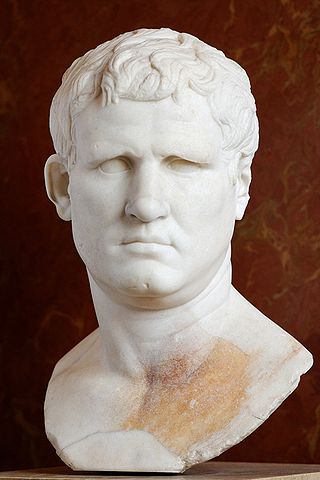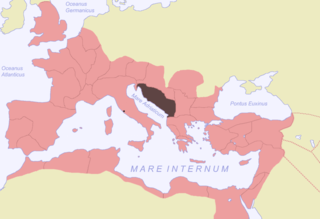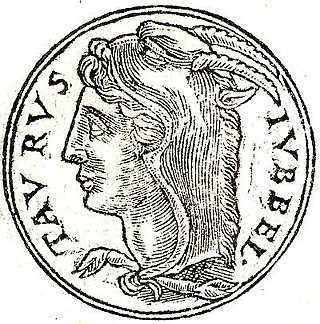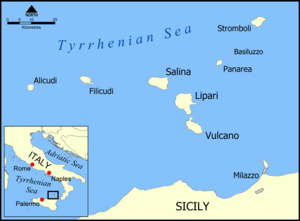
The Battle of Actium was a naval battle fought between Octavian's maritime fleet, led by Marcus Agrippa, and the combined fleets of both Mark Antony and Cleopatra VII Philopator. The battle took place on 2 September 31 BC in the Ionian Sea, near the former Roman colony of Actium, Greece, and was the climax of over a decade of rivalry between Octavian and Antony.

Marcus Vipsanius Agrippa was a Roman general, statesman and architect who was a close friend, son-in-law and lieutenant to the Roman emperor Augustus. Agrippa is well known for his important military victories, notably the Battle of Actium in 31 BC against the forces of Mark Antony and Cleopatra. He was also responsible for the construction of some of the most notable buildings of his era, including the original Pantheon.

Marcus Antonius, commonly known in English as Mark Antony, was a Roman politician and general who played a critical role in the transformation of the Roman Republic from a constitutional republic into the autocratic Roman Empire.
This article concerns the period 39 BC – 30 BC.

Milazzo is a municipality in the Metropolitan City of Messina, Sicily, southern Italy; it is the largest commune in the Metropolitan City after Messina and Barcellona Pozzo di Gotto. The town has a population of around 31,500 inhabitants.
Year 36 BC was either a common year starting on Tuesday, Wednesday or Thursday or a leap year starting on Wednesday of the Julian calendar and a common year starting on Wednesday of the Proleptic Julian calendar. At the time, it was known as the Year of the Consulship of Poplicola and Nerva. The denomination 36 BC for this year has been used since the early medieval period, when the Anno Domini calendar era became the prevalent method in Europe for naming years.

The Second Triumvirate was an extraordinary commission and magistracy created for Mark Antony, Lepidus, and Octavian to give them practically absolute power. It was formally constituted by law on 27 November 43 BC with a term of five years; it was renewed in 37 BC for another five years before expiring in 32 BC. Constituted by the lex Titia, the triumvirs were given broad powers to make or repeal legislation, issue judicial punishments without due process or right of appeal, and appoint all other magistrates. The triumvirs also split the Roman world into three sets of provinces.

Gnaeus Domitius Ahenobarbus was a general and politician of ancient Rome in the 1st century BC.

Sextus Pompeius Magnus Pius, also known in English as Sextus Pompey, was a Roman military leader who, throughout his life, upheld the cause of his father, Pompey the Great, against Julius Caesar and his supporters during the last civil wars of the Roman Republic.

Illyricum was a Roman province that existed from 27 BC to sometime during the reign of Vespasian. The province comprised Illyria/Dalmatia in the south and Pannonia in the north. Illyria included the area along the east coast of the Adriatic Sea and its inland mountains, eventually being named Dalmatia. Pannonia included the northern plains that now are a part of Serbia, Croatia and Hungary. The area roughly corresponded to part or all of the territories of today's Albania, Kosovo, Montenegro, Serbia, Bosnia and Herzegovina, Croatia, and Slovenia.
The naval Battle of Naulochus was fought on 3 September 36 BC between the fleets of Sextus Pompeius and Marcus Vipsanius Agrippa, off Naulochus, Sicily. The victory of Agrippa, admiral of Octavian, marked the end of the Pompeian resistance to the Second Triumvirate.

Sicilia was the first province acquired by the Roman Republic, encompassing the island of Sicily. The western part of the island was brought under Roman control in 241 BC at the conclusion of the First Punic War with Carthage. A praetor was regularly assigned to the island from c. 227 BC. The Kingdom of Syracuse under Hieron II remained an independent ally of Rome until its defeat in 212 BC during the Second Punic War. Thereafter the province included the whole of the island of Sicily, the island of Malta, and the smaller island groups.
Quintus Salvius Salvidienus Rufus was a Roman general and one of the principal generals and advisors of Octavian during the early years of his political activity.
Lucius Cornificius, a member of the plebeian gens Cornificia, was a Roman politician and consul in 35 BC.

Naulochus, Naulochos, Naulochoi, or Naulocha, was an ancient city of Magna Graecia on the north coast of Sicily, between Mylae and Cape Pelorus. It is known primarily from the great sea-fight in which Sextus Pompeius was defeated by Marcus Vipsanius Agrippa, 36 BCE, and which was fought between Mylae and Naulochus. Pompeius himself during the battle had been encamped with his land forces at Naulochus, and after his victory, Octavian, in his turn, took up his station there, while Agrippa and Lepidus advanced to attack Messana. It is clear from its name that Naulochus was a place where there was a good roadstead or anchorage for shipping. Some have doubted its existence as a populated place, but Silius Italicus includes it in his list of Sicilian cities. From the description in Appian it is clear that it was situated between Mylae and Cape Rasoculmo, and probably not very far from the latter point; but there is nothing to fix its site more definitely. The editors of the Barrington Atlas of the Greek and Roman World place it near the modern comune of Spadafora.

The Bellum Siculum was an Ancient Roman civil war waged between 42 BC and 36 BC by the forces of the Second Triumvirate and Sextus Pompey, the last surviving son of Pompey the Great and the last leader of the Optimate faction. The war consisted of mostly a number of naval engagements throughout the Mediterranean Sea and a land campaign primarily in Sicily that eventually ended in a victory for the Triumvirate and Sextus Pompey's death. The conflict is notable as the last stand of any organised opposition to the Triumvirate.

Titus Statilius Taurus was the name of a line of Roman senators. The first known and most important of these was a Roman general and two-time consul prominent during the Triumviral and Augustan periods. The other men who bore this name were his descendants.
Marcus Titius was a Roman politician and commander at the end of the Roman Republic.
Papias was a Roman admiral in the 1st century BC. During the Roman civil wars he participated in Sicilian revolt under the command of Sextus Pompeius.
Quintus Nasidius, sometimes referred to as Lucius Nasidius, was a Roman naval commander who lived during the 1st century BC and sided with the Optimates during Caesar's Civil War.











